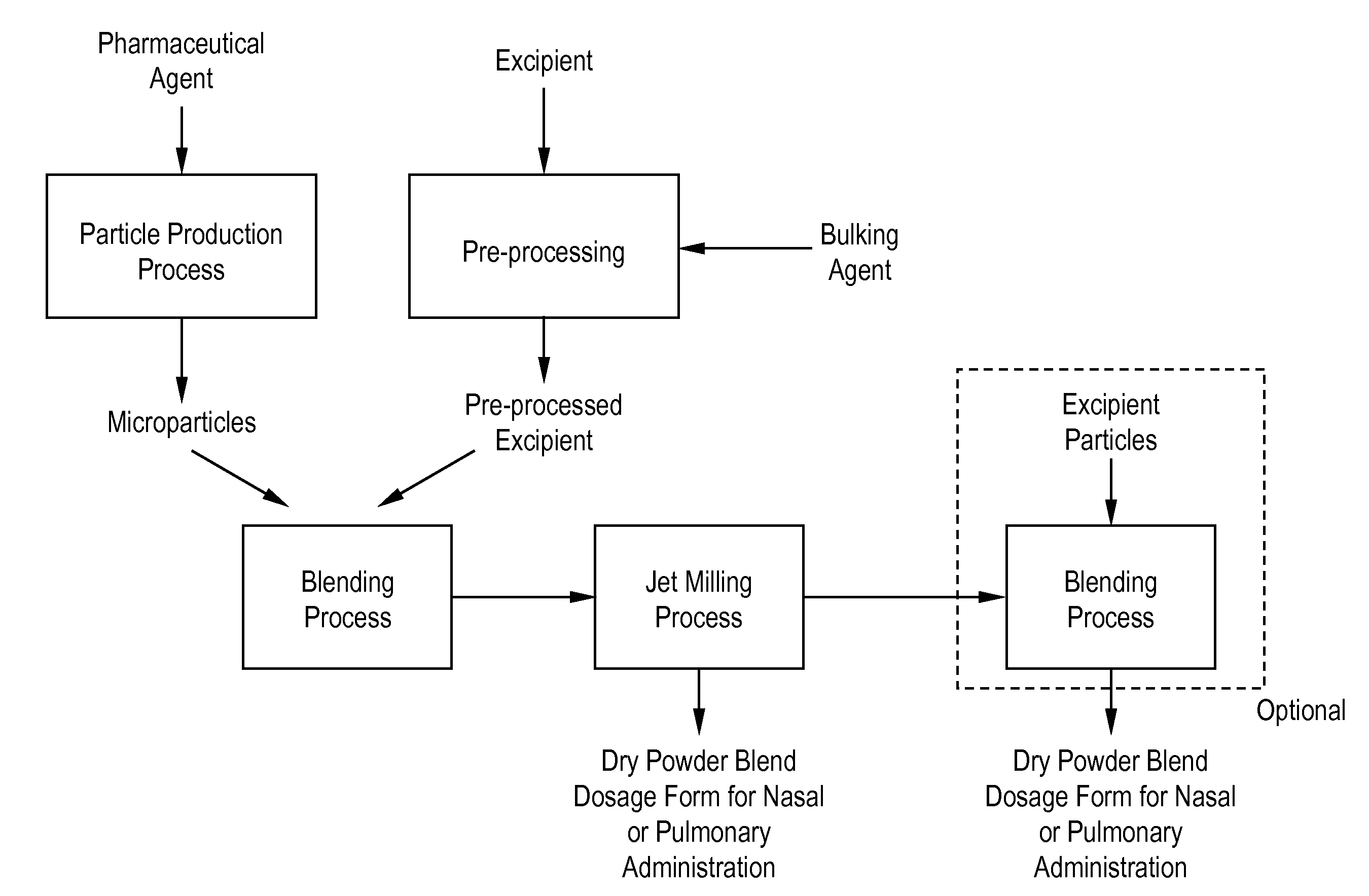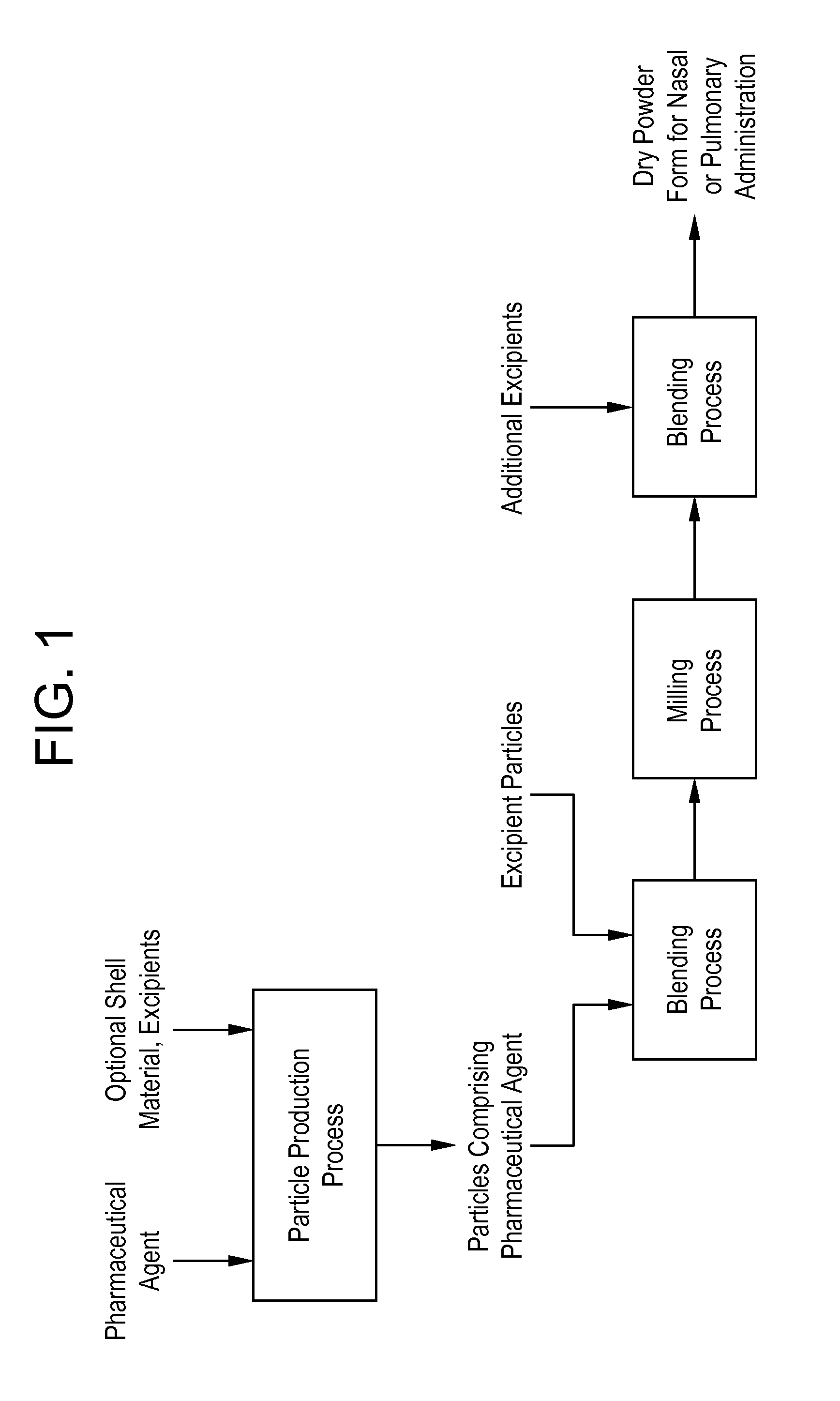Processes for making particle-based pharmaceutical formulations for pulmonary or nasal administration
a technology of pharmaceutical formulations and blends, applied in the direction of medical preparations, powder delivery, microcapsules, etc., can solve the problems of difficult milling or mixing with pharmaceutical agent microparticles, certain desirable excipient materials, and complicated production and scale-up, so as to improve stability and facilitate storage
- Summary
- Abstract
- Description
- Claims
- Application Information
AI Technical Summary
Benefits of technology
Problems solved by technology
Method used
Image
Examples
example 1
Microparticle Dispersibility Comparison of Reconstituted Celecoxib Blend Formulations Made by Different Methods
[0143] A dry powder blend formulation was prepared by one of three different processes and then reconstituted in water. The dry powder blend consisted of celecoxib, mannitol, Plasdone-C15, and Tween80 at a ratio of 5:10:1:1. The mannitol (Pearlitol 100SD from Roquette America Inc., Keokuk, Iowa) and the Tween80 were pre-processed, at a ratio of 10:1, by dissolution in water (18 g mannitol and 1.8 g Tween80 in 104 mL water) followed by freezing at −80° C. and lyophilization. The three processes compared were (1) blending the celecoxib and pre-processed excipient particles without milling, (2) separately milling the celecoxib particles and then blending the milled particles with pre-processed excipients, or (3) blending the celecoxib and pre-processed excipient particles and then milling the resulting blend. The resulting blends were reconstituted in water using shaking, and...
example 2
Production of Microparticles Containing Budesonide
[0147] Two different samples of budesonide were prepared. Sample 2a was prepared as follows: 8.0 g of PLGA, 0.48 g of DPPC, and 2.2 g of budesonide were dissolved in 392 mL of methylene chloride, and 1.1 g of ammonium bicarbonate was dissolved in 10.4 g of water. The ammonium bicarbonate solution was combined with the budesonide / PLGA solution and emulsified using a rotor-stator homogenizer. The resulting emulsion was spray dried on a benchtop spray dryer using an air-atomizing nozzle and nitrogen as the drying gas. Spray drying conditions were as follows: 20 mL / min emulsion flow rate, 60 kg / hr drying gas rate and 21° C. outlet temperature. The product collection container was detached from the spray dryer and attached to a vacuum pump, where the collected product was dried for 53 hours.
[0148] Sample 2b was prepared as follows: 36.0 g of PLGA, 2.2 g of DPPC, and 9.9 g of budesonide were dissolved in 1764 mL of methylene chloride, an...
example 3
Production of Microparticles Comprising Fluticasone Propionate
[0149] Microparticles containing fluticasone propionate were made as follows: 3.0 g of PLGA, 0.36 g of DPPC, and 2.2 g of fluticasone propionate were dissolved in 189 mL of methylene chloride, and 0.825 g of ammonium bicarbonate was dissolved in 7.6 g of water. The ammonium bicarbonate solution was combined with the fluticasone priopionate / PLGA solution and emulsified using a rotor-stator homogenizer. The resulting emulsion was spray dried on a benchtop spray dryer using an air-atomizing nozzle and nitrogen as the drying gas. Spray drying conditions were as follows: 20 mL / min emulsion flow rate, 60 kg / hr drying gas rate and 20° C. outlet temperature. The product collection container was detached from the spray dryer and attached to a vacuum pump, where the collected product was dried for 49 hours. Two batches made according to the above method were manually blended to create a single combined batch.
PUM
 Login to View More
Login to View More Abstract
Description
Claims
Application Information
 Login to View More
Login to View More - R&D
- Intellectual Property
- Life Sciences
- Materials
- Tech Scout
- Unparalleled Data Quality
- Higher Quality Content
- 60% Fewer Hallucinations
Browse by: Latest US Patents, China's latest patents, Technical Efficacy Thesaurus, Application Domain, Technology Topic, Popular Technical Reports.
© 2025 PatSnap. All rights reserved.Legal|Privacy policy|Modern Slavery Act Transparency Statement|Sitemap|About US| Contact US: help@patsnap.com



